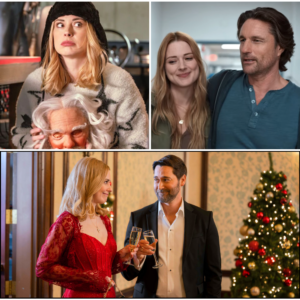In the shadowed opulence of Clarence House, where portraits of stern-faced ancestors gaze down from gilded walls, King Charles III sat across from his youngest son, Prince Harry, for a meeting that lasted precisely one hour. It was September 2025, 19 months since their last face-to-face encounter, and the air was thick with the weight of unspoken grievances, half-hearted apologies, and the faint scent of Earl Grey tea. Harry, at 41, had flown in from California’s sun-soaked sprawl for the WellChild Awards, a charity event close to his heart that harkens back to his days as a working royal. But this wasn’t just a filial check-in amid his father’s ongoing cancer battle; it was a crossroads, a moment where the threads of family loyalty tangled with the cold calculus of commerce. Charles, 76 and weary from treatments that have thinned his once-robust frame, laid it bare: no half-measures. If Harry wanted any semblance of reconciliation—or, heaven forbid, a partial return to the fold—he’d have to choose. The Crown’s honor and duties, or the glittering $120 million media empire he’s built with his wife, Meghan Markle, in the hills of Montecito. One path leads home; the other, deeper into exile.
The ultimatum, leaked to the press like so many royal secrets before it, has ignited a firestorm across tabloids, social media, and drawing rooms from London to Los Angeles. “The King has been absolutely clear in upholding his late mother’s decision that there can be no ‘half-in, half-out’ public role for members of the family,” a palace insider confided to The Times, echoing the Sandringham Summit’s edict from 2020. Queen Elizabeth II, in her final years, had drawn a firm line: royals couldn’t monetize their titles and connections while dipping toes back into official service. It was a rule born of pragmatism, designed to shield the monarchy from accusations of crass commercialism. For Harry, it means torching the deals that have sustained his post-Megxit life—the Netflix productions, the speaking gigs fetching $1 million a pop, the memoir royalties still trickling in from Spare‘s explosive sales. Charles’s door, sources say, remains cracked open for a son, but slammed shut on a celebrity. “This isn’t about punishment,” the insider added. “It’s about integrity. You can’t serve two masters.”
Harry’s camp pushed back swiftly, with a rare statement branding the details “categorically false” and insisting the duke’s focus was solely on his father’s health. “The duke has made it clear that the focus has to be on his dad,” his spokesperson told outlets like People magazine. “Beyond that, and on any other issues as it relates to his family, we won’t be commenting.” Yet the denial rang hollow to skeptics, who point to Harry’s history of selective candor—Oprah interviews decrying institutional racism, a Netflix docuseries airing palace laundry, a book that detailed a physical clash with brother William and painted Camilla as a scheming stepmother. The meeting itself was a test of trust: Charles, ever the environmentalist at heart, reportedly gifted Harry a potted plant symbolizing growth, while Harry presented a framed photo of Archie and Lilibet, now 6 and 4, their cherubic faces a silent plea for grandfatherly thawing. But leaks emerged almost immediately—details of the tea’s tone, the duration, the unspoken tensions—fueling speculation that Harry’s side couldn’t resist the narrative pull.
To understand the stakes, one must rewind to January 2020, when Harry and Meghan stunned the world by announcing their step-back from senior royal roles. Dubbed “Megxit” in headlines that evoked Brexit’s bitterness, it was framed as a quest for independence from the suffocating scrutiny that had hounded them since their 2018 wedding. Meghan, the trailblazing biracial actress from Suits, spoke of racial undertones in the press; Harry, haunted by his mother’s paparazzi-chased death, cited safety fears. They envisioned a hybrid life: part-time royals, splitting time between Frogmore Cottage and a North American base, funding their own way while upholding duties. The Sandringham talks dashed that dream. Elizabeth, flanked by Charles and William, decreed no hybrids allowed. Stripped of HRH suffixes for public use, evicted from Frogmore in 2023 after Spare‘s fallout, the Sussexes decamped to a $14.7 million Montecito mansion, its nine bedrooms and guest house a fortress against the world they once commanded.
Exile bred reinvention, and reinvention meant revenue. The couple’s Archewell Productions inked a $100 million Netflix pact in 2020, a five-year bonanza promising docuseries, scripted fare, and lifestyle content. Harry & Meghan dropped in 2022, a six-hour tell-all that racked up 28 million hours viewed in its first week, blending love story with institutional critique. Harry’s Heart of Invictus followed, chronicling wounded warriors in a nod to his military past. Meghan’s With Love, Meghan, a cooking and crafting show, debuted to middling buzz in 2025, peaking at No. 10 globally with 2.6 million views. Polo, Harry’s equestrian passion project, streamed to acclaim. But cracks appeared: Spotify axed their $25 million podcast deal in 2023, citing “terrible” output. Netflix, eyeing renewal, balked at extensions amid underwhelming returns—rumors swirled of a looser, non-exclusive pact worth far less. Enter the $120 million figure: industry whispers peg it as the cumulative windfall from Netflix alone, bolstered by Spare‘s $20 million advance (plus $7 million in bonuses), speaking fees, and Meghan’s lifestyle ventures like her American Riviera Orchard jam line. It’s a fortune that affords private jets, round-the-clock security ($3 million annually, self-funded after losing UK police protection), and a veneer of A-list glamour. Yet it’s tethered to their royal cachet—the very titles Charles now demands they relinquish for any comeback.
For Charles, the calculus is personal and precarious. Diagnosed with an unspecified cancer in February 2024, he’s leaned on William and Kate, both navigating their own health trials, to shoulder a “slimmed-down” monarchy. The king’s reign, meant to modernize the Firm with eco-initiatives and inclusivity, has been overshadowed by Sussex scandals. Spare sold 6 million copies, but alienated core supporters; the Netflix series drew 81 million viewers, yet amplified rifts. Charles, who once dreamed of a united front with all three heirs—William the steady, Harry the spirited, George the future—now grapples with a prodigal’s defiance. Insiders say the monarch aches for his grandchildren, unseen save for video calls, and yearns for Harry’s Invictus legacy to shine under the royal umbrella. But trust is fractured. “Harry has to pass the trust test,” a family friend told Vanity Fair. Leaks, like the reunion’s minutiae, only widen the chasm. William, 43 and heir apparent, remains a stone wall—refusing contact since Spare‘s brotherly brawl revelation, prioritizing his nuclear family and duties. “William believes giving Harry any imprimatur is a huge mistake,” the friend added. With Charles’s health “far worse than the Palace lets on,” per Hollywood whispers, the king’s ultimatum feels like a succession safeguard: mend or meander forever.
Public reaction has been a maelstrom. On X (formerly Twitter), royal watchers erupted. “Prince Harry and Meghan Markle have ruined King Charles’s reign,” fumed one user, decrying their “grifting” as a legacy stain. Others rallied for Harry: “Charles wants to be on good terms with both sons. He fully realizes how ‘special’ Prince Harry is.” Feminists hailed Meghan’s independence; traditionalists decried her Balenciaga Fashion Week appearance—rumored at $1 million—as title-tainting tawdriness. Polls show divided loyalties: 52% of Brits sympathize with the Sussexes’ privacy pleas, per YouGov, but 68% oppose a partial return. In Montecito, Harry and Meghan press on—her podcast Confessions of a Female Founder launches this fall, his BetterUp coaching role thrives—but whispers of financial strain persist. The mansion’s upkeep devours millions; Netflix’s tepid renewal leaves gaps. Harry’s UK visits, like September’s, come sans family due to security snubs, a sore point since his 2024 court loss.
At its core, this isn’t just about $120 million or a velvet throne—it’s a son’s search for belonging in a family forged by loss. Harry’s childhood, scarred by Diana’s 1997 death, bred a protector’s zeal; Megxit was his bid to shield his own brood from similar shadows. Charles, who endured his own parental chill under the Windsors’ stoic code, sees echoes of his youth—relegated to Camilla’s sidelines while Diana dazzled. Yet reconciliation demands sacrifice. If Harry folds his hand, ditching deals for duties, he reclaims a counselor of state role (shared uneasily with Andrew and Edward) and perhaps a Balmoral invite. But Meghan? Her narrative thrives on autonomy; trading Netflix sets for ribbon-cuttings feels like retreat. Sources hint at tentative thaws: courtiers plotting more father-son teas, even a joint event signaling unity. “It’s about father and son,” Harry’s team insists, but the dollars dangling complicate the dirge.
As autumn leaves swirl over Windsor Great Park, the choice looms like a gathering storm. Will Harry, the once-spare now fully freelance, trade Tinseltown’s temptations for the Crown’s corseted comfort? Or does Charles’s door creak shut for good, leaving a king to ponder his legacy amid the echoes of what might have been? In palaces and podcasts alike, one truth endures: thrones aren’t built on trust alone, but on the hard choices that crown them.


